FBG-Based Sensitivity Structure Based on Flexure Hinge and Its Application for Pipeline Pressure Detection
Abstract
:1. Introduction
2. Principle of FBG Sensors and Pipeline Mechanical Model
2.1. Basic Sensing Theory of FBG
2.2. Analyses of Pipeline Stress-Strain State
3. Structural Design and Theoretical Calculation
3.1. Sensitization Structure Design
3.2. Static Analyses of Structures
- (1)
- The displacement only occurs at the circle hinge, and the rest of the flexure hinge sheet can be considered to be rigid.
- (2)
- The circle hinge only produces rotational displacement.
4. Simulation and Optimization
4.1. Analysis of Pipeline Wall Strain
4.2. Sensitivity Analysis of the Critical Dimensions
4.3. Sensitization Ability of the Structure
5. Experimental Testing and Analyses of Results
5.1. Experimental System Setup and Results
5.2. Analyses of Experimental Results
6. Conclusions
Author Contributions
Funding
Institutional Review Board Statement
Informed Consent Statement
Data Availability Statement
Conflicts of Interest
References
- Yang, J.; Mostaghimi, H.; Hugo, R.; Park, S.S. Pipeline leak and volume rate detections through Artificial intelligence and vibration analysis. Measurement 2022, 187, 110368. [Google Scholar] [CrossRef]
- Zheng, X.; Wang, Q.; Xue, S.; Zheng, C. A beamforming-based joint estimation method for gas pipeline leak localization. Measurement 2021, 177, 109264. [Google Scholar] [CrossRef]
- Zonn, I.S.; Kostianoy, A.G. Environmental risks in production and transportation of hydrocarbons in the Caspian—Black sea region. Oil Gas Pipelines Black Casp. Seas Reg. 2015, 51, 211–223. [Google Scholar]
- Connolly, R.J.; Brown, D.; Darr, D.; Morse, J.; Laskowski, B. Corrosion Detection on Buried Transmission Pipelines with Micro-linear Polarization Resistance Sensors. In Engineering Asset Management-Systems, Professional Practices and Certification; Springer: Berlin/Heidelberg, Germany, 2015; pp. 673–685. [Google Scholar]
- Kim, M.; Oh, S.; Jeong, W.; Talantsev, A. Highly bendable planar Hall resistance sensor. IEEE Magn. Lett. 2020, 11, 1–5. [Google Scholar] [CrossRef]
- Reddy, S.K.; Gendelis, I.; Ya’akobovitz, A. Vertically aligned carbon nanotubes capacitive sensors. IEEE Sens. J. 2019, 19, 4375–4380. [Google Scholar] [CrossRef]
- Rivadeneyra, A.; López-Villanueva, J.A. Recent advances in printed capacitive sensors. Micromachines 2020, 11, 367. [Google Scholar] [CrossRef]
- Prasad, A.; Sebastian, S.; Asokan, S. Diaphragm-micro-stylus-based fiber Bragg grating tactile sensor. IEEE Sens. J. 2020, 20, 6394–6399. [Google Scholar] [CrossRef]
- Liu, H.; Zhu, Z.; Zheng, Y.; Liu, B.; Xiao, F. Experimental study on an FBG strain sensor. Opt. Fiber Technol. 2018, 40, 144–151. [Google Scholar] [CrossRef]
- Takashima, S.; Asanuma, H.; Niitsuma, H. A water flowmeter using dual fiber Bragg grating sensors and cross-correlation technique. Sens. Actuators A Phys. 2004, 116, 66–74. [Google Scholar] [CrossRef]
- Riza, M.A.; Go, Y.I.; Harun, S.W.; Maier, R.R.J. FBG sensors for environmental and biochemical applications—A review. IEEE Sens. J. 2020, 20, 7614–7627. [Google Scholar] [CrossRef]
- Campanella, C.E.; Cuccovillo, A.; Campanella, C.; Yurt, A.; Passaro, V.M.N. Fibre Bragg grating based strain sensors: Review of technology and applications. Sensors 2018, 18, 3115. [Google Scholar] [CrossRef] [PubMed]
- Li, X.; Jia, L.; Bin, G. Design of a Novel Experimental Instrument for Quasi-Distributed Fiber Bragg Grating Sensing. J. Electron. Meas. Instrum. 2008, 22, 67–71. [Google Scholar]
- Ma, C.; Ma, N. Comparison of Theoretical Calculation and Experimental Testing of the Sensitivity of a Fiber Bragg Grating Strain Sensor. In Proceedings of the Optical Sensing and Detection VI. International Society for Optics and Photonics, Online, 1 April 2020. [Google Scholar]
- Hong, C.-Y.; Zhang, Y.-F.; Zhang, M.-X.; Leung, L.M.G.; Liu, L.-Q. Application of FBG sensors for geotechnical health monitoring, a review of sensor design, implementation methods and packaging techniques. Sens. Actuators A Phys. 2016, 244, 184–197. [Google Scholar] [CrossRef]
- Wu, H.; Guo, Y.; Xiong, L.; Liu, W.; Li, G.; Zhou, X. Optical fiber-based sensing, measuring, and implementation methods for slope deformation monitoring: A review. IEEE Sens. J. 2019, 19, 2786–2800. [Google Scholar] [CrossRef]
- Ling, H.; Lau, K.; Cheng, L.; Jin, W. Viability of using an embedded FBG sensor in a composite structure for dynamic strain measurement. Measurement 2006, 39, 328–334. [Google Scholar] [CrossRef]
- Zhou, Z.; Tan, Y.; Liu, M.; Yang, W.; Li, Z. Actualities and development on dynamic monitoring and diagnosis with distributed fiber Bragg grating in mechanical systems. J. Mech. Eng. 2013, 49, 55–69. [Google Scholar] [CrossRef]
- Jia, Z.; Wang, Z.; Sun, W.; Li, Z. Pipeline leakage localization based on distributed FBG hoop strain measurements and support vector machine. Optik 2019, 176, 1–13. [Google Scholar] [CrossRef]
- Li, R.; Chen, Y.; Tan, Y.; Zhou, Z.; Li, T.; Mao, J. Sensitivity enhancement of FBG-based strain sensor. Sensors 2018, 18, 1607. [Google Scholar] [CrossRef]
- Hu, D.; Lv, S.; Guo, Y.; He, H.; Liu, J. A Fiber Bragg Grating Force Sensor with Sensitization Structure. IEEE Sens. J. 2020, 21, 3042–3048. [Google Scholar] [CrossRef]
- Li, L.; Zhang, D.; Liu, H.; Guo, Y. Design of an enhanced sensitivity FBG strain sensor and application in highway bridge engineering. Photonic Sens. 2014, 4, 162–167. [Google Scholar] [CrossRef]
- Liu, M.; Wang, W.; Song, H.; Zhou, S.; Zhou, W. A high sensitivity FBG strain sensor based on flexible hinge. Sensors 2019, 19, 1931. [Google Scholar] [CrossRef] [PubMed]
- Peng, J.; Jia, S.; Jin, Y.; Xu, S.; Xu, Z. Design and investigation of a sensitivity-enhanced fiber Bragg grating sensor for micro-strain measurement. Sens. Actuators A Phys. 2019, 285, 437–447. [Google Scholar] [CrossRef]
- Yan, Z.; Chen, G.; Xu, C.; Xu, W. Design and experimental study of a sensitization structure with fiber grating sensor for nonintrusive pipeline pressure detection. ISA Trans. 2020, 101, 442–452. [Google Scholar] [CrossRef] [PubMed]
- Shu, Q.; Wu, L.; Lu, S.; Xiao, W. High-sensitivity structure based on fiber Bragg grating sensor and its application in nonintrusive detection of pipeline pressure change. Measurement 2021, 189, 110444. [Google Scholar] [CrossRef]
- Liang, M.; Fang, X.; Song, Y.; Li, S.; Chen, N.; Zhang, F. Research on Three-Dimensional Stress Monitoring Method of Surrounding Rock Based on FBG Sensing Technology. Sensors 2022, 22, 2624. [Google Scholar] [CrossRef]
- Fajkus, M.; Kovar, P.; Skapa, J.; Nedoma, J.; Martinek, R.; Vasinek, V. Design of Fiber Bragg Grating Sensor Networks. IEEE Trans. Instrum. Meas. 2021, 71, 7001411. [Google Scholar] [CrossRef]
- Ciaglia, F.M.; Di Cosmo, F.; Marmo, G.; Schiavone, L. Evolutionary equations and constraints: Maxwell equations. J. Math. Phys. 2019, 60, 113503. [Google Scholar] [CrossRef]
- Othonos, A. Fiber bragg gratings. Rev. Sci. Instrum. 1997, 68, 4309–4341. [Google Scholar] [CrossRef]
- Zhu, D.; Ren, N.; Wang, Q. Pitting life prediction based on a 3D line contact mixed EHL analysis and subsurface von Mises stress calculation. J. Tribol. 2009, 131, 041501. [Google Scholar] [CrossRef]

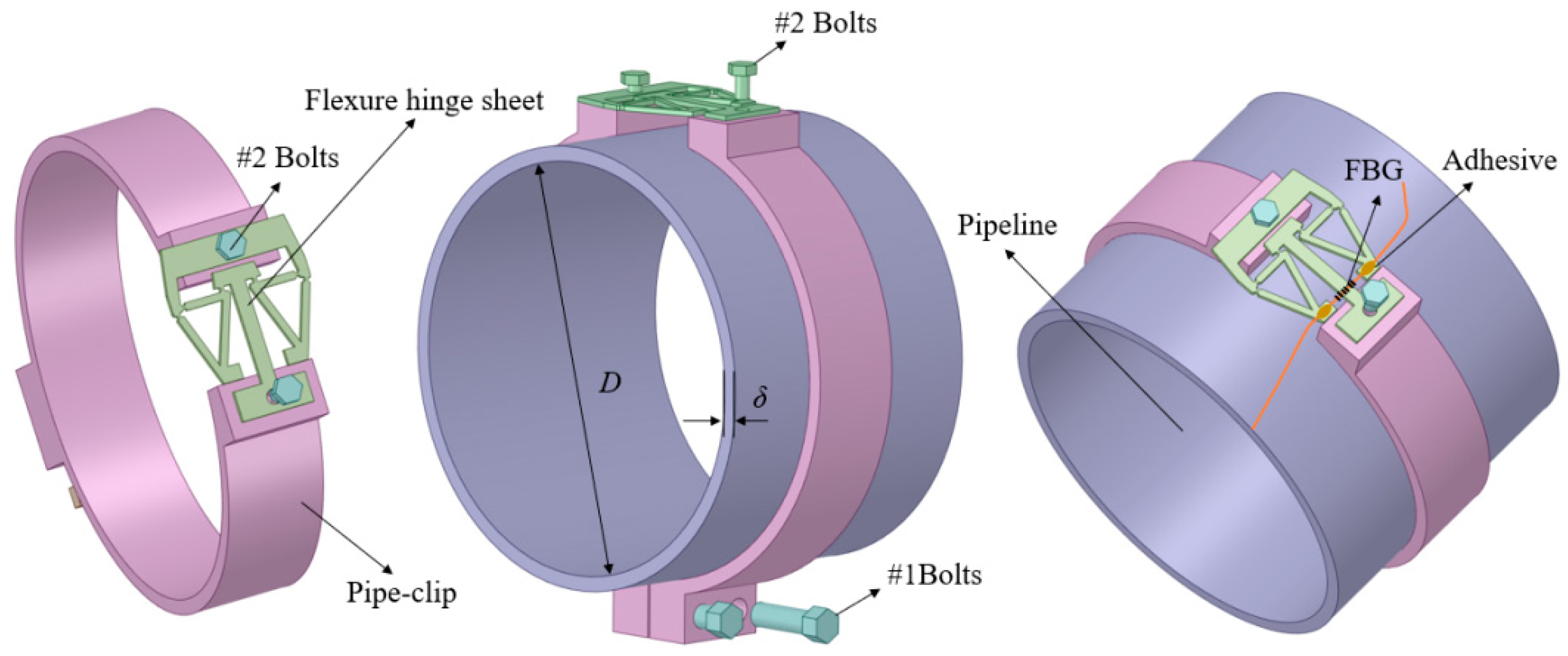
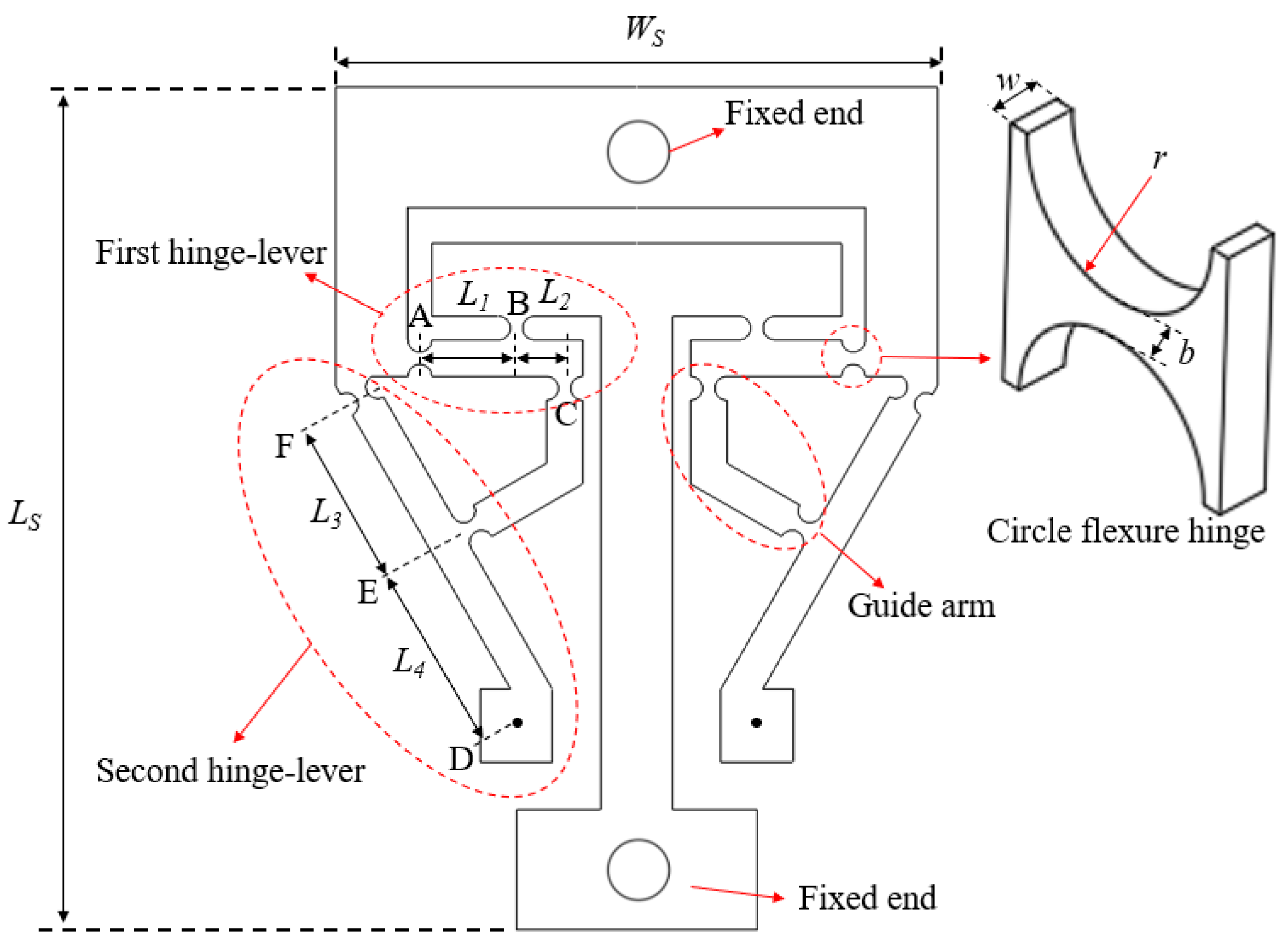



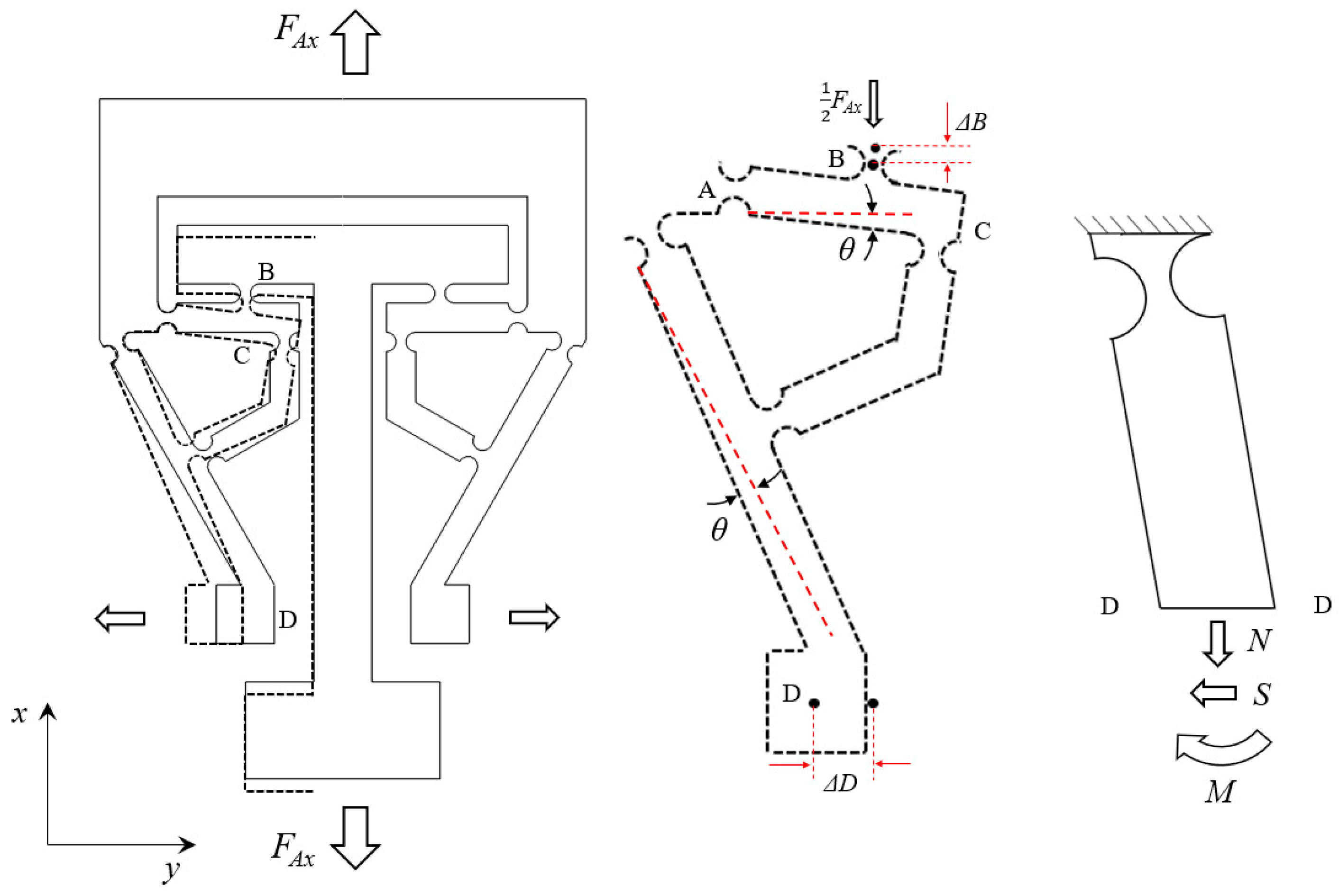
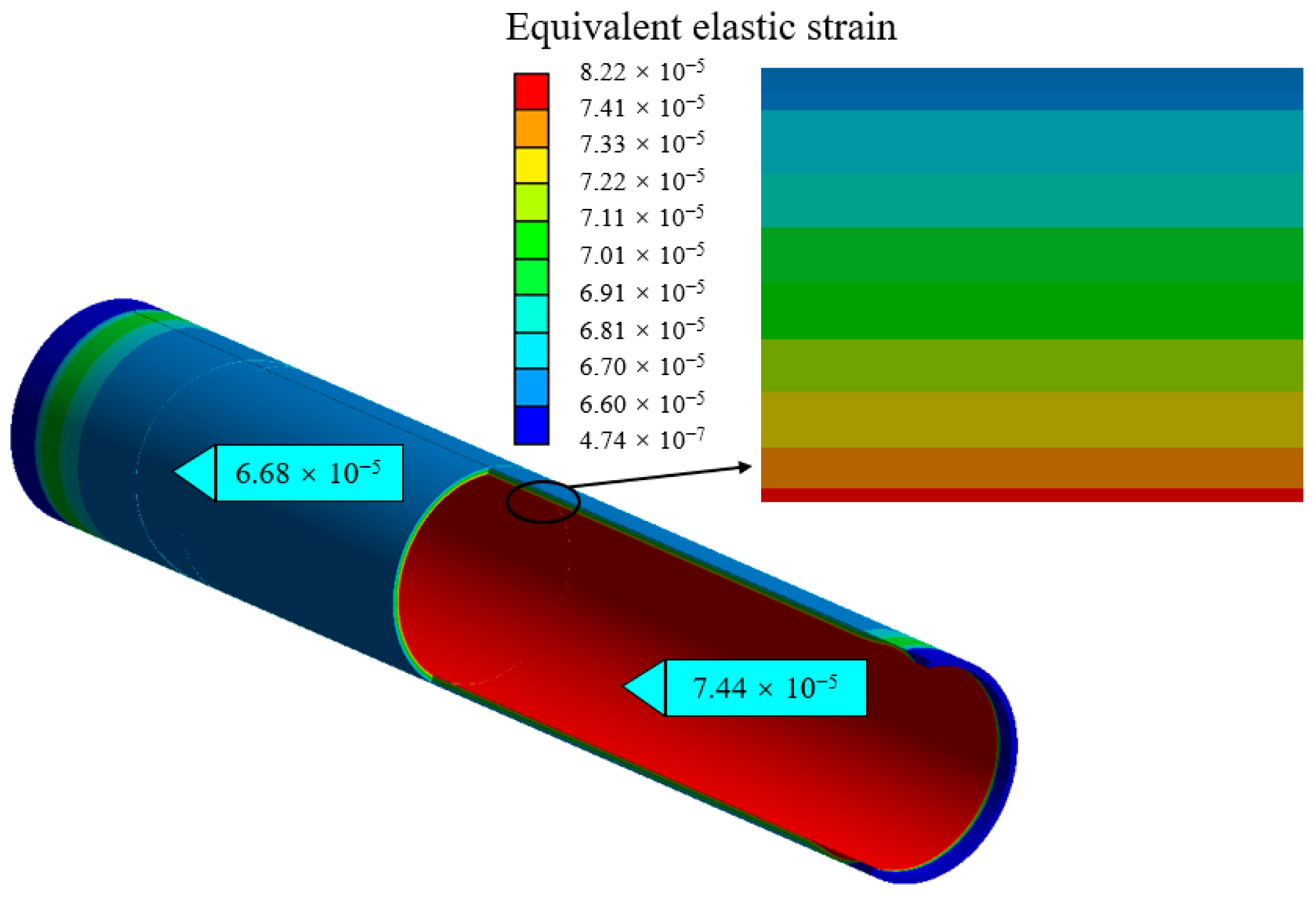
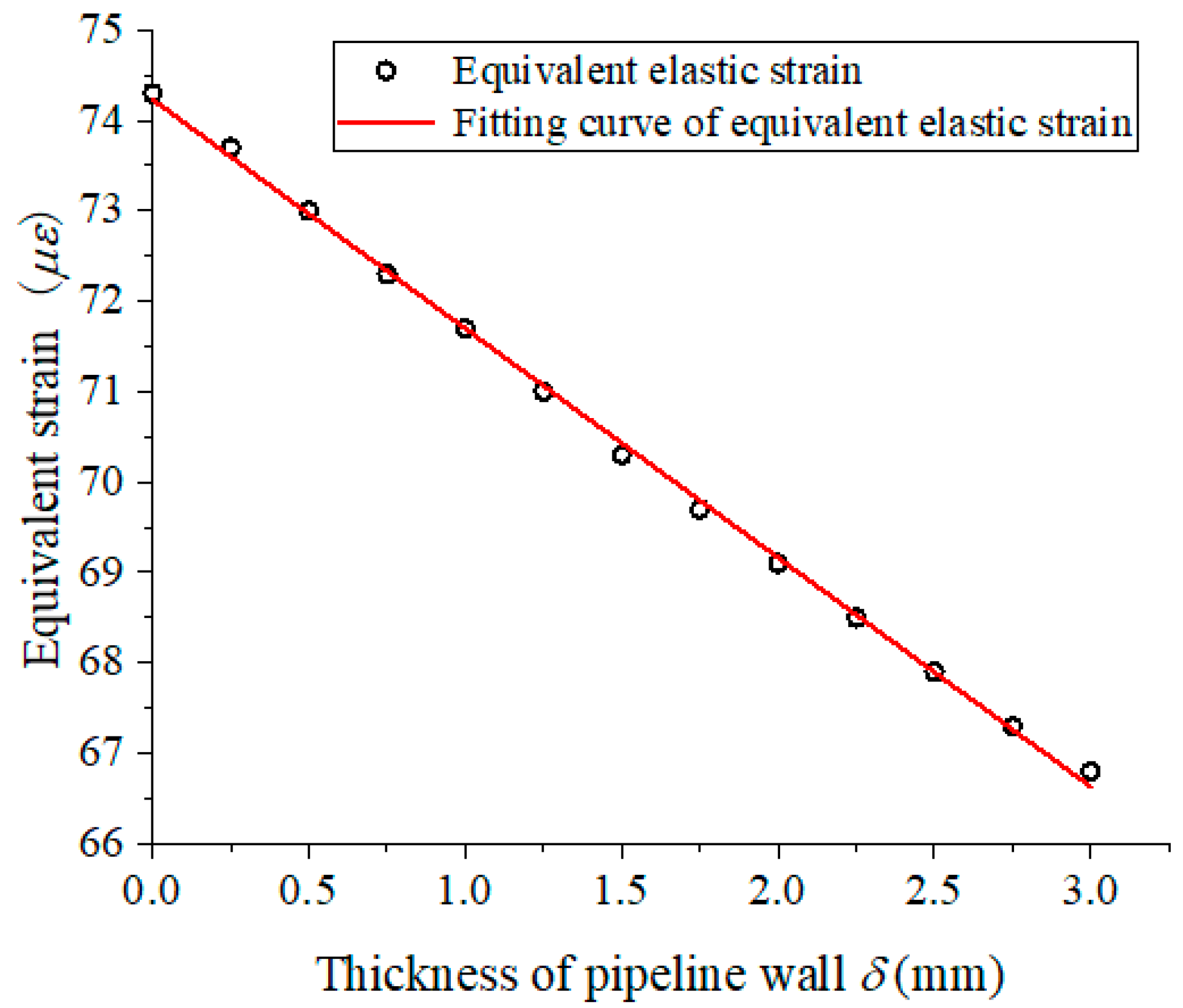

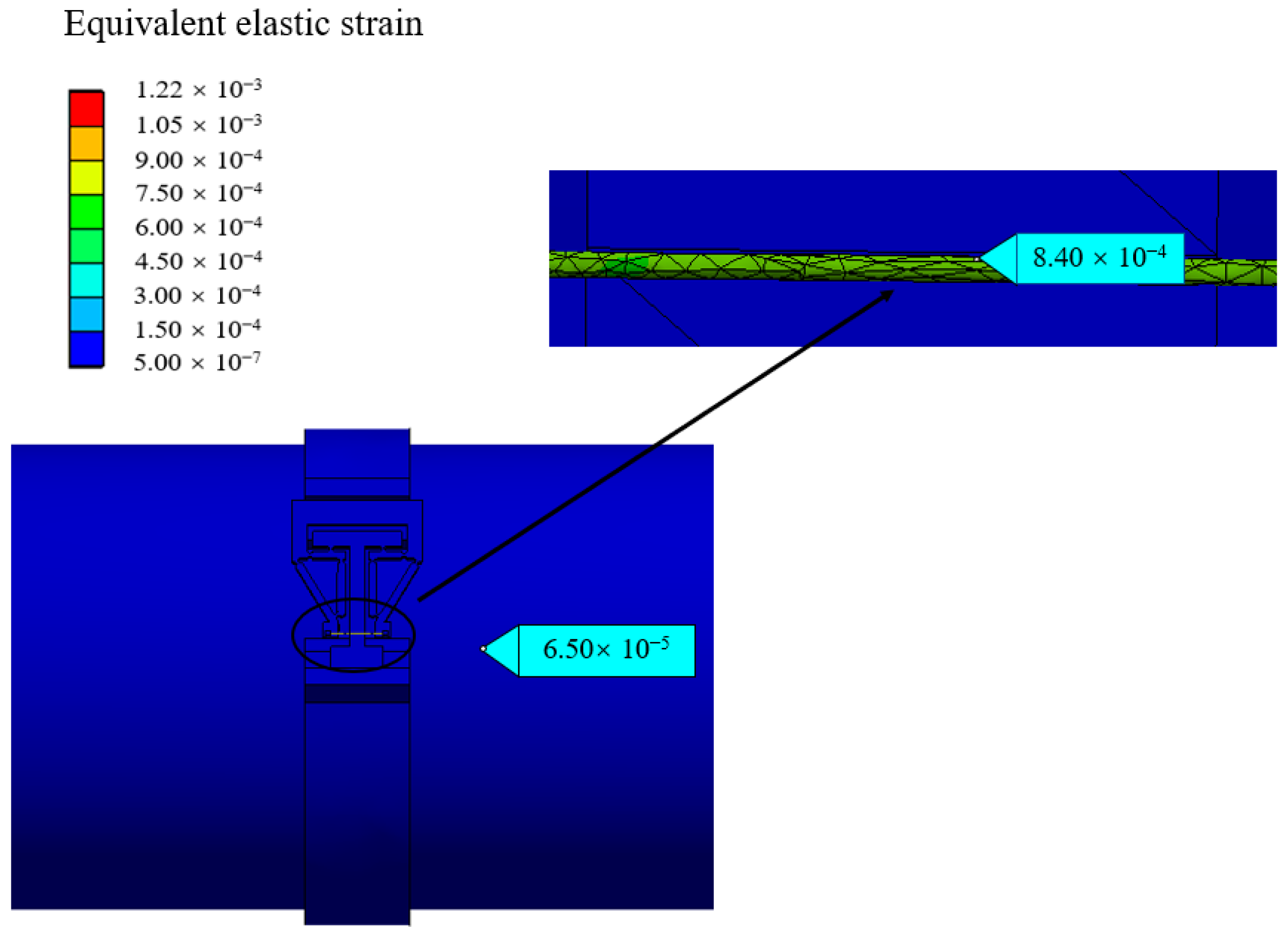
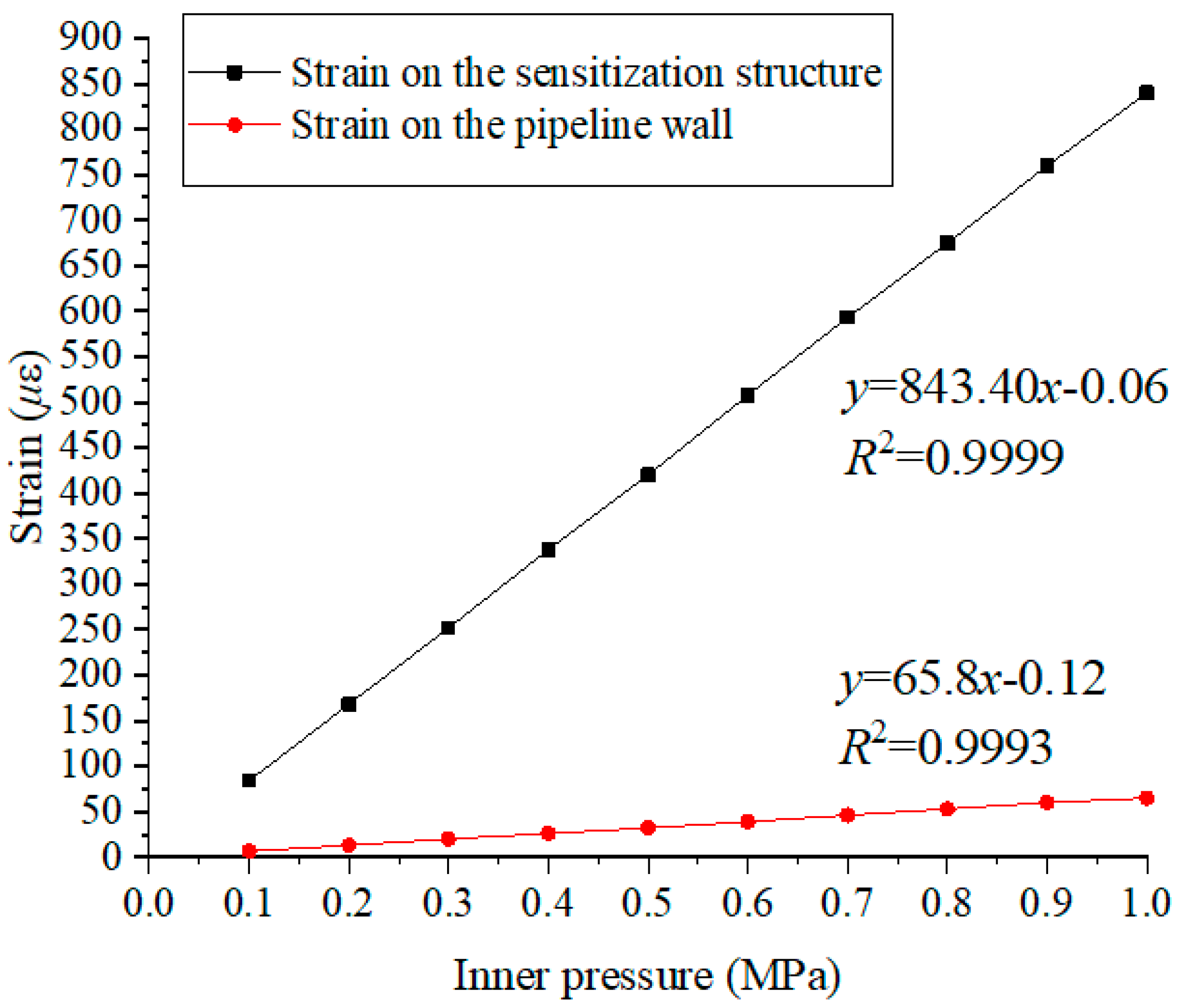

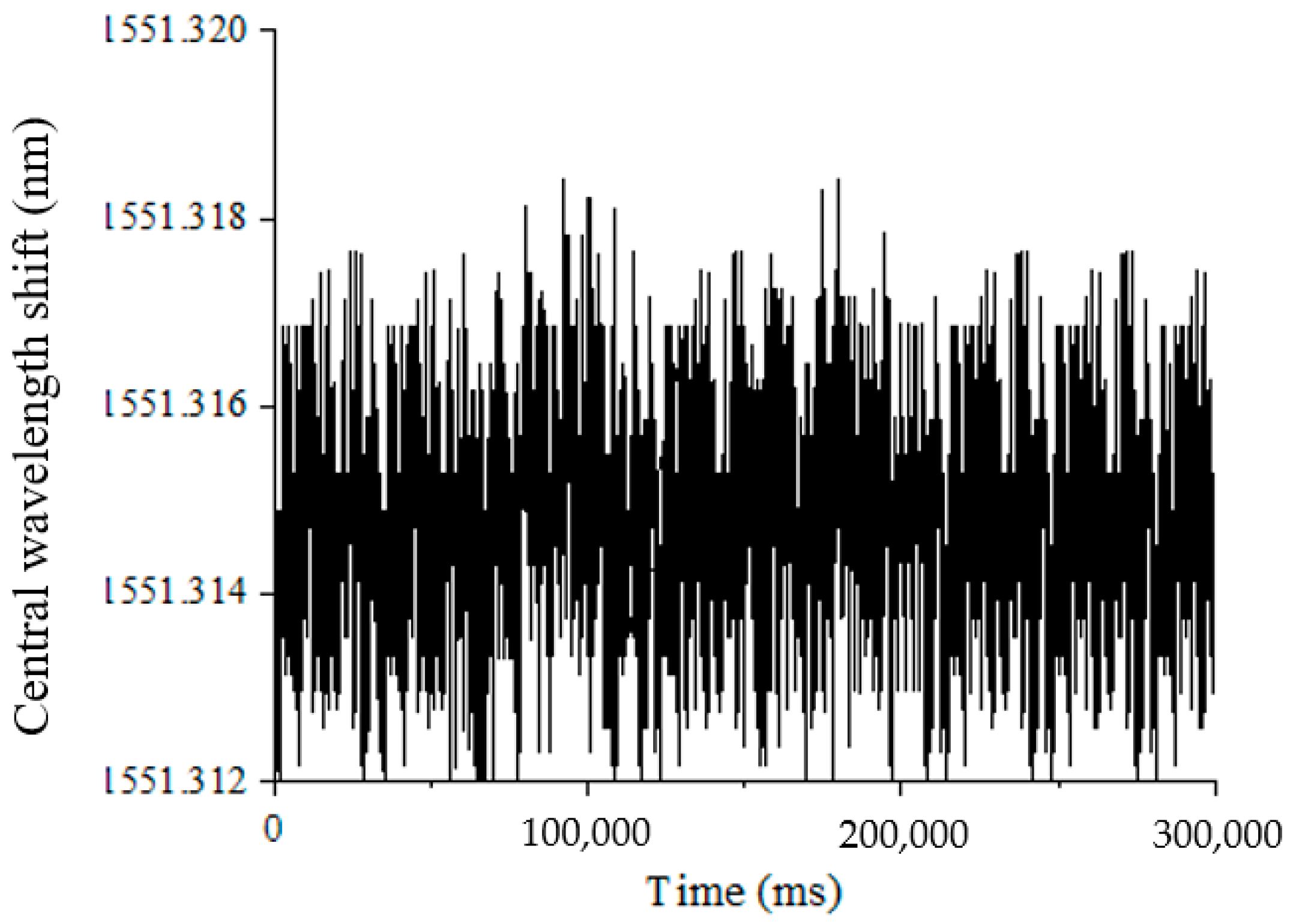
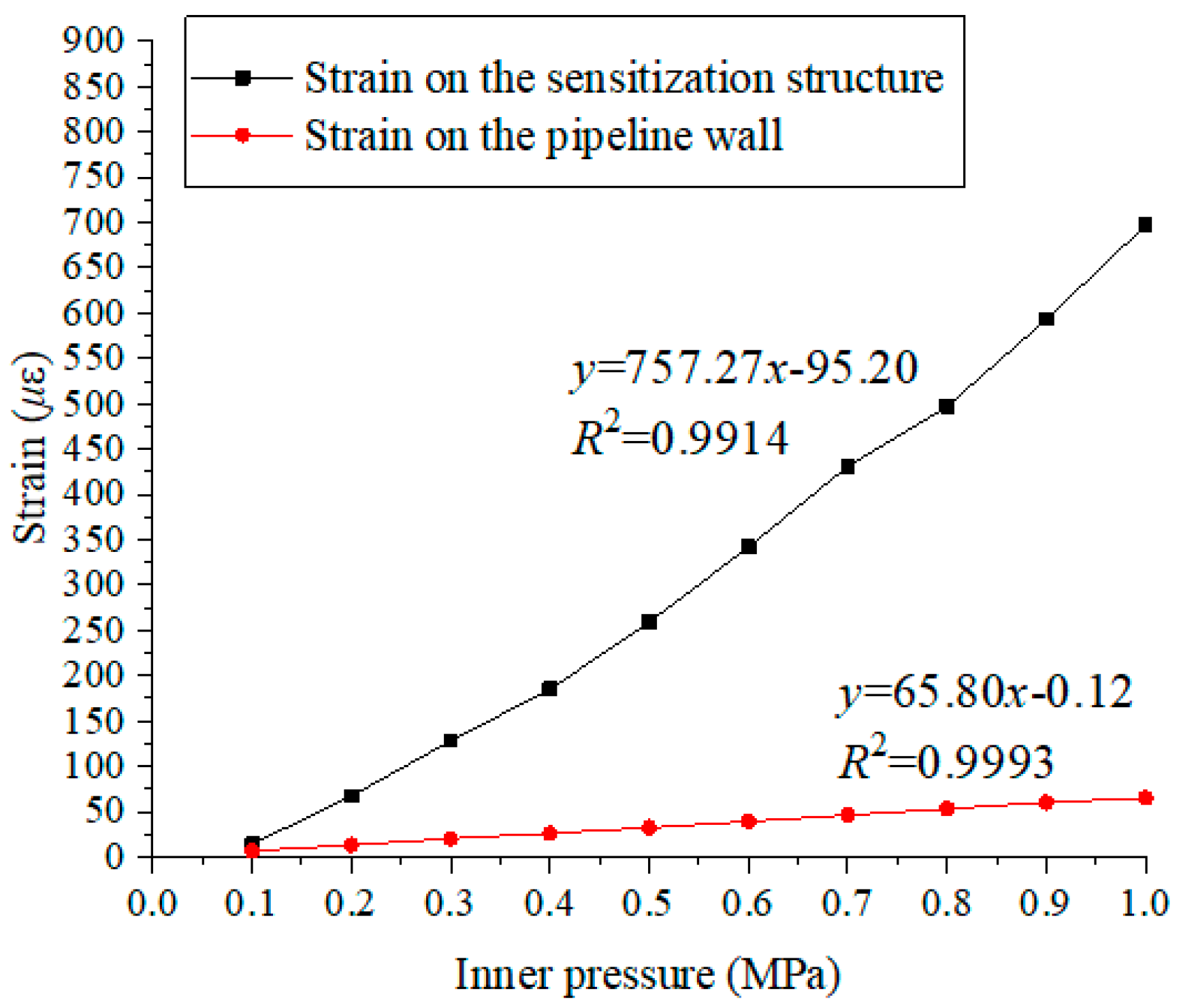
| Parameter | δp | L1-L2 | L3-L4 | r | w | Ws | Ls |
|---|---|---|---|---|---|---|---|
| Initial dimension | 3 mm | 3–3 mm | 6–7 mm | 1 mm | 1 mm | 20 mm | 30 mm |
| Symbol | Description (Unit) | Value |
|---|---|---|
| D | Inside diameter of pipeline (mm) | 83.0 |
| L1-L2 | First hinge-lever (mm) | 3.0–3.0 |
| L3-L4 | Second hinge-lever (mm) | 13.0–2.0 |
| δ | Wall thickness of pipeline (mm) | 3.0 |
| w | Thickness of flexure hinge sheet (mm) | 1.0 |
| δp | Thickness of pipe-clip (mm) | 3.0 |
| Ls | Length of the flexure hinge sheet (mm) | 30.0 |
| Ws | Width of the flexure hinge sheet (mm) | 20.0 |
| αf | Thermal expansion coefficient of fiber (°C) | 0.5 × 10−6 |
| ξ | Thermo-optical coefficient of fiber (°C) | 6.4 × 10−6 |
| E | Young’s modulus of the sensitization structure (GPa) | 200.0 |
| μ | Poisson’s ratio of the sensitization structure | 0.33 |
| Central Wavelength [nm] | FBG Length [mm] | Reflectivity [%] | |
|---|---|---|---|
| #1FBG | 1551.705 | 10 | 91.09 |
| #2FBG | 1551.500 | 10 | 93.69 |
| #3FBG | 1551.315 | 10 | 95.24 |
| Pressure (MPa) | 0.1 | 0.2 | 0.3 | 0.4 | 0.5 | 0.6 | 0.7 | 0.8 | 0.9 | 1.0 | ||
|---|---|---|---|---|---|---|---|---|---|---|---|---|
| Pressurized cycle (µε) | Sample 1 | 11.67 | 55.83 | 106.67 | 154.17 | 215.83 | 285.00 | 359.17 | 414.17 | 494.17 | 580.83 | |
| Sample 2 | 10.83 | 54.17 | 104.17 | 155.00 | 214.17 | 284.17 | 358.33 | 417.50 | 490.83 | 577.50 | ||
| Relative error of the slope/% | 0.32 | |||||||||||
| Depressurized cycle (µε) | Sample 1 | 12.50 | 57.50 | 108.33 | 158.33 | 212.50 | 282.50 | 364.17 | 408.33 | 487.50 | 580.00 | |
| Sample 2 | 12.50 | 57.50 | 105.83 | 152.50 | 210.83 | 282.50 | 360.83 | 422.50 | 487.50 | 575.00 | ||
| Relative error of the slope/% | 0.43 | |||||||||||
Publisher’s Note: MDPI stays neutral with regard to jurisdictional claims in published maps and institutional affiliations. |
© 2022 by the authors. Licensee MDPI, Basel, Switzerland. This article is an open access article distributed under the terms and conditions of the Creative Commons Attribution (CC BY) license (https://creativecommons.org/licenses/by/4.0/).
Share and Cite
Liu, Z.; Lu, S.; Wang, D.; Guo, Y.; Wu, L. FBG-Based Sensitivity Structure Based on Flexure Hinge and Its Application for Pipeline Pressure Detection. Materials 2022, 15, 5661. https://doi.org/10.3390/ma15165661
Liu Z, Lu S, Wang D, Guo Y, Wu L. FBG-Based Sensitivity Structure Based on Flexure Hinge and Its Application for Pipeline Pressure Detection. Materials. 2022; 15(16):5661. https://doi.org/10.3390/ma15165661
Chicago/Turabian StyleLiu, Zhongyan, Shunzhi Lu, Deguo Wang, Yanbao Guo, and Lei Wu. 2022. "FBG-Based Sensitivity Structure Based on Flexure Hinge and Its Application for Pipeline Pressure Detection" Materials 15, no. 16: 5661. https://doi.org/10.3390/ma15165661





